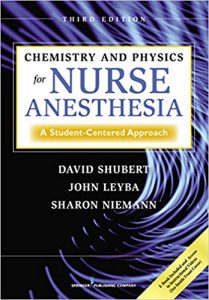Chemistry and Physics for Nurse Anesthesia, Third Edition
 With a focus on chemistry and physics content that is directly relevant to the practice of anesthesia, this text–written in an engaging, conversational style–supplies all the scientific information required for the combined chemistry and physics course for nurse anesthesia students. Now in its third edition, the text is updated and reorganized to facilitate a greater ease and depth of understanding. The addition of a third author–a practicing nurse anesthetist–enhances the clinical relevance of the scientific information. Clinical scenarios now begin every chapter, and a concluding chapter, new to this edition, provides detailed, step-by-step solutions to the book’s review questions. Also included is a comprehensive list of need-to-know equations.
With a focus on chemistry and physics content that is directly relevant to the practice of anesthesia, this text–written in an engaging, conversational style–supplies all the scientific information required for the combined chemistry and physics course for nurse anesthesia students. Now in its third edition, the text is updated and reorganized to facilitate a greater ease and depth of understanding. The addition of a third author–a practicing nurse anesthetist–enhances the clinical relevance of the scientific information. Clinical scenarios now begin every chapter, and a concluding chapter, new to this edition, provides detailed, step-by-step solutions to the book’s review questions. Also included is a comprehensive list of need-to-know equations.
The third edition retains the many outstanding learning features from earlier editions, including a special focus on gases, the use of illustrations to demonstrate how scientific concepts relate directly to their clinical application in anesthesia, and end-of-chapter summaries and review questions to facilitate self-assessment. Fifteen online videos enhance teaching and learning, and abundant clinical application scenarios help reinforce scientific principles and relate them to day-to-day anesthesia procedures. This clear, easy-to-read text will help even the most chemistry- and physics-phobic students to master the foundations of these sciences and competently apply them in a variety of clinical situations.
NEW TO THE THIRD EDITION:
Increased focus on clinical relevance
Revised and updated chapters foster ease of understanding
Clinical application scenarios open each chapter
A new chapter provides guidance about calculator use and a unique problem-solving method
Detailed step-by-step solutions clarify answers to end-of-chapter problems
Comprehensive list of all key equations with explanation of symbols
KEY FEATURES:
Written in an engaging, informal style for ease of understanding
Focuses solely on chemistry and physics principles relevant to nurse anesthetists
Provides end-of-chapter summaries and review questions
Fifteen online videos enhance teaching and learning
Includes abundant illustrations that apply theory to practice
About the Author
David Shubert, PhD, is a dean in the College of Arts and Sciences at Newman University, Wichita, Kansas, where until recently he designed and cotaught the combined chemistry-physics for nurse anesthesia course with Dr. Leyba. He was inducted into the national Achievement Rewards for College Scientists (ARCS) Foundation prior to joining Newman University in 1987. Although his area of expertise lies in organometallic chemistry, Dr. Shubert has taught introductory, general, organic, analytical, and instrumental analytical chemistry, as well as biochemistry, earth and space science, general physical science, and chemistry/physics for nurse anesthesia. In 1995, Dr. Shubert was honored by his students and peers with the Teaching Excellence Award. He has worked as a chemical consultant with several local industries, including Vulcan Chemicals and BG Products. Working with colleagues from five independent colleges, and with financial support from the National Science Foundation, the Camille and Henry Dreyfus Foundation, and the A. V. Davis Foundation, Dr. Shubert has offered numerous workshops that provided training and access to modern instrumentation to high school chemistry teachers. Most recently, he was recognized by the “Wichita Business Journal” in 2014 as a Healthcare Hero. His research interests have evolved from organometallic chemistry to chemical education.
[amazon template=iframe image&asin=0826107826]
–